The best 120Hz 4K TVs 2024, ideal for PS5 and Xbox Series X
Looking to upgrade to a TV with a 120Hz refresh rate for next-gen gaming? These are the top options

1. The list in brief
2. Best overall
3. Best value TV
4. Best mid-range TV for PS5
5. Best for sizes
6. Best cheap OLED
7. Best premium OLED
8. 120Hz OLED for PS5
9. How to choose
10. How we test
11. Latest updates
The best 120Hz 4K TVs are essential for both gamers and movie lovers. The 4K resolution they deliver brings you extra pixels for better clarity and combined with a 120Hz refresh rate, your games and movies look buttery smooth.
If you're a gamer, a 120Hz refresh rate means you’ll not only see things much more clearly in motion, but you'll see faster response times – the best 120Hz TVs dominate our list of the best gaming TVs for these reasons. This guide also has 144Hz TVs in, which can be useful for PC gaming. These TVs all also support 120Hz for consoles. Meanwhile, 24fps movies can play without the frustrating judder you may have noticed on some cheaper TVs, if you have a source that can deliver this, such as an Apple TV 4K (2022).
We test the best 120Hz TVs with the latest gaming consoles to make sure they work as intended, and we use specialist equipment to measure the input lag ourselves – it's not about what manufacturers claim, but about what you get in real life. We also check their image quality, naturally – everything still needs to look great!
The quick list
Want to cut to the chase and find out which 120Hz TVs are the best? Below, you’ll find a roundup of our choices. You can also jump to a more detailed write-up of every TV for more information, based on our in-depth reviews.
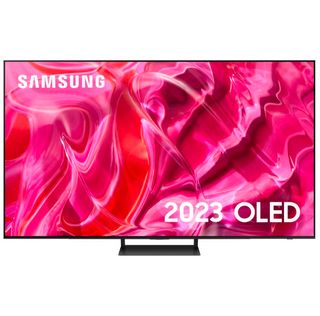
The best 120Hz TV for most people
The Samsung S90C offers a whole host of gaming features including 4K 120Hz, plus a brighter and contrast-rich picture thanks to its exciting QD-OLED technology.
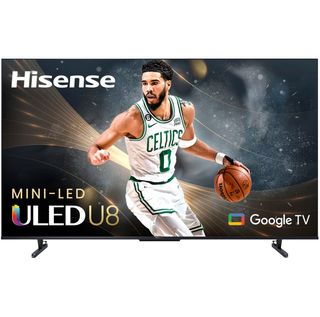
The best value 120Hz TV
The Hisense U8K provides up to 144Hz refresh rate, VRR, and ALLM for gaming and combines it with a bright enough picture for daytime use, all for an affordable price.

The best mid-range 120Hz TV for PS5
The X90L delivers great performance at a good price, and features Sony's 'Perfect for PS5' tech, so you get the best HDR from that console, even at 120Hz.
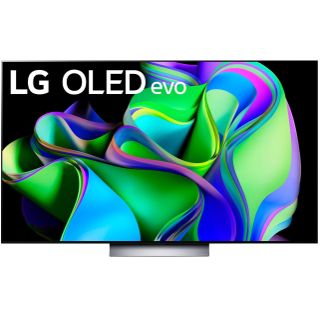
The best 120Hz TV for sizes
The LG C3 is available in sizes from 42 inches to 83 inches, all with 4K 120Hz support, so it covers more bases than anything else here – and it looks wonderful.

The best cheap 120Hz OLED TV
This is the cheapest OLED you can get with a 4K 120Hz screen. It's less bright than the LG C2, but you still get OLED's great contrast for a lower price.
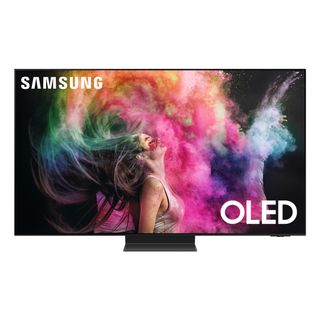
The best premium 120Hz OLED TV
A gamer's dream, the Samsung S95C offers extensive gaming features alongside a super-bright OLED image.
Load the next products...
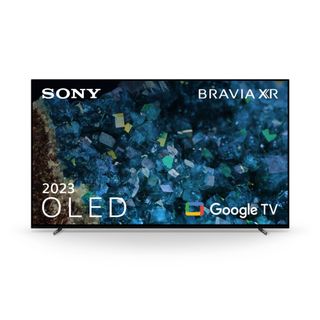
An ideal 120Hz OLED TV for PS5
A 'Perfect for PS5' TV, this gives you OLED picture quality at a low price if you want all of Sony's best tricks, including an advanced HDR mode just for PS5.

I've been testing and reporting on TVs since 2017, but my experience writing about and reviewing screen technology stretches back to 2010. I love seeing all the latest TV releases as they come through our testing rooms, and I shape this guide by working with our reviewers and editors, to decide which 120Hz TVs offer the best value and features over the competition and get our recommendation.
Recent updates
11 April 2024
Updated with testing results graphs, to make it easy to compare our TVs recommendations.
The best 120Hz TV for most people

Specifications
Reasons to buy
Reasons to avoid
✅ You want a well-featured gaming TV: The Samsung S90C has plenty of gaming features including 144Hz, VRR, ALLM, AMD FreeSync Premium and Samsung's Game Hub.
✅ You want a phenomenal picture: The S90C has stunning contrast and black levels and vivid color that gets the best out of both gaming and movies.
❌ You want the brightest QD-OLED picture: The Samsung S95C offers the brightest QD-OLED picture if you want that extra dazzle for your games.
❌You want Dolby Vision for your games: The Samsung S90C doesn't support Dolby Vision so Xbox Series X owners may want to take this into account.
The Samsung S90C is the best option for most people, with a picture that captures the contrast-rich images and deep blacks of an OLED, coupled with the stunning brightness of a QLED. This results in a picture that gives it an edge over the LG C2 (featured further down our list) and C3.
For gamers, there is support for HDMI 2.1 across all four ports, VRR, ALLM and a host of other gaming features including a dedicated game bar and hub to really get the best out of your games – and support for both 4K 120Hz or 4K 144Hz from PC.
Although it lacks Dolby Vision for Xbox Series X gamers and movie viewing, the picture itself is dynamic and bright enough that you get an excellent level of HDR impact without it.
The S90C may lack the even more ridiculous brightness of the S95C (also in this list) but we found in our review of the S90C that images are "actually more consistent and therefore immersive than those of its flagship siblings". And with the S90C being so much cheaper than the S95C, you really are getting better value for money.
Getting the best of both OLED and QLED technology in one picture at a more budget friendly price than the S95C and Sony A95K is a no-brainer, if your budget stretches to it. Even its built-in audio is good. Paired with all the great gaming features on offer, it's no surprise that the S90C is our pick for best 120Hz TV overall. But there's a caveat about the 83-inch model – this uses a totally different OLED panel. While it's still a 120Hz TV, it's nowhere near as bright as the other sizes.
Read our full Samsung S90C review
The best value 120Hz TV
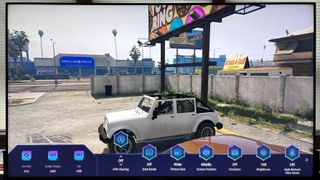
Specifications
Reasons to buy
Reasons to avoid
✅ You want a brilliant value gaming TV: The Hisense U8K has a lot of gaming features such as 144hz and VRR in a budget-friendly mini-LED TV.
✅ You want a bright picture while gaming: Thanks to mini-LED tech, the U8K has high brightness that suits brighter rooms well.
❌ You want a cloud gaming hub: The U8K doesn't come with a built-in cloud gaming hub that you'll find on other brands such as Samsung.
❌You want multiple viewing angles: When viewed off-center, the Hisense U8K's contrast does fade so you won't be getting the best picture from all angles.
The Hisense U8K has extensive gaming features combined with great picture quality with great brightness and deep black levels all in at an affordable price. Using mini-LED technology for high brightness levels, the Hisense U8K is great for daytime viewing.
In terms of gaming, the Hisense U8K is a surprisingly well-stocked TV. With two HDMI 2.1 ports that offer a refresh rate of up to 144Hz, Dolby Vision, VRR (in the form of FreeSync Premium Pro) and ALLM support, the Hisense U8K is an ideal option for gaming, especially for those with particularly bright environments. The only downside is that there's only two HDMI 2.1 ports, as opposed to the four you'll find on some of the other best gaming TVs.
Despite focusing on brightness, thanks to that mini-LED technology, the Hisense U8K also offers deep black levels for an excellent contrast. Unfortunately, this contrast does fade somewhat when viewed off-center. However, thanks to its anti-glare coating and a high peak brightness of 1,590 nits (which tops any OLED TV available today) it makes light work of brighter viewing environments.
The U8K also provides good audio quality, with deep bass as a highlight and a useful design, thanks to its adjustable-width support feet. The Hisense U8K may not be the best gaming TV on the market, but it gives you a whole lot of bang for your buck.
Read our full Hisense U8K review
Best mid-range 120Hz for PS5

Specifications
Reasons to buy
Reasons to avoid
✅ You are a PS5 owner: The Sony X90L has Sony's Auto HDR feature, which tailors HDR tone mapping when a PS5 is detected.
✅ You want a great picture for your games: The X90L has superb 'infinite' contrast levels and improved brightness for a better overall picture.
❌ You want the best gaming performance: The X90L has a high 18.2ms input lag, even in gaming mode, which is much higher than a lot of cheaper sets.
❌You need multiple HDMI 2.1 ports: With only two HDMI 2.1 ports, those with multiple consoles and soundbars are going to need to look at alternative solutions.
Thanks to its 'Perfect for PS5' technology, gaming features and above average LED brightness, the Sony X90L is a no brainer if you are looking for a mid-range, 120Hz TV to go with your PS5.
The Sony X90L is a great option for gaming, with 120Hz, VRR and ALLM support and 'Perfect for PS5' features. 'Perfect for PS5' means that when a PS5 is connected, the X90L will use its auto HDR tone mapping feature to get the best picture out of your games on the PS5. Frustratingly, it has an average input lag time of 18.2ms, which is higher than all the other TVs on this list and only two 2.1 HDMI ports, but it still has very good gaming performance overall.
In terms of picture, the Sony X90L's most striking feature is its brighter-than-average LED picture. Its peak brightness measured at 1,225 nits in our testing, which is brighter than a lot of OLED and LED TVs, including the brilliant Samsung S90C. Thanks to this brightness, images on the Sony X90L are punchy and feature crisp details, that'll not only look great with games but also movies.
Sound quality and design are also solid on the Sony X90L, with clear dialogue and an attractive, slim design to the set itself. Yes, it may be more expensive than some OLED and mini-LED TVs on the market, but considering its high brightness and gaming features, the Sony X90L is an excellent gaming option.
Read our full Sony X90L review
The best 120Hz TV for sizes
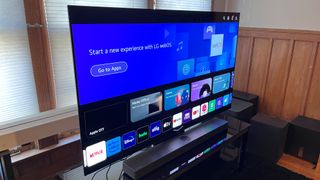
Specifications
Reasons to buy
Reasons to avoid
✅ You want a range of sizes: Available in sizes from 42- to 83-inch, the C3 is available for all situations whether its bedroom or living room gaming.
✅ You want a lot of gaming support: Four HDMI 2.1 ports, Dolby Vision gaming, a Game Optimizer mode and cloud gaming options are just some of the C3's gaming features.
❌ You want the brightest TV: The C3 has decent brightness, but there are several OLEDs and mini-LEDs brighter than it.
❌You need powerful built-in audio: The LG C3's sound system comprises of 2.2ch and isn't one of the most immersive on the market.
The LG C3 is the best TV around right now at a price that's not cheap, but would be considered reasonable by most for a high-performance TV. It's available in a range of sizes, including as a 42-inch model, making it the smallest 120Hz TV in this list. That means it's ideal for gamers who want to fit the best tech into the smallest space – but it's got so many sizes, it's great for whatever you need.
Whichever size you pick, you get a fully-equipped suite of four HDMI 2.1 ports, with support for 4K 120Hz (including Dolby Vision gaming at 120fps – still a rare feature), VRR (including FreeSync and G-Sync), and ALLM.
LG’s Alpha9 Gen6 chip is here, which is used for picture processing and brings new HDR-improving features, including OLED Dynamic Tone Mapping Pro and Expression Enhancer, both of which have an impact on image quality.
LG’s C3 OLED looks good, with a slim bezel and aluminum-faced center stand. Connectivity options are excellent, too, though it does lack the built-in ATSC 3.0 digital TV tuner found in LG’s step-up G3 series models. Overall, this is a fantastic 120Hz TV and it's our pick for the best if you're looking for a range of sizes, all the way down to the small 42-inch model.
Read our full LG C3 OLED TV review
The best cheap 120Hz OLED TV

Specifications
Reasons to buy
Reasons to avoid
✅ You want OLED gaming for cheaper: The LG B3 offers a lot of brilliant gaming features and OLED picture for a cheaper price than other OLED TVs.
✅ You want great gaming performance: It's not the top performer, but the B3's picture and gaming performance combine to make a fantastic gaming option.
❌ You want the full gaming experience: The LG B3 doesn't have four HDMI 2.1 ports like you'll find on TVs such as the LG C3 and Samsung S90C.
❌You want the physically best TV: The LG B3's supplied stand feels a little on the cheap side, which is disappointing for what is still a pricy TV for a lot of people.
As the entry-level model in LG's 2023 OLED TV lineup, the LG B3 comes packed with plenty of gaming features, a gorgeous picture that rivals more premium TVs and a great price (that continues to fall). It's the cheapest you can get a 2023 TV with120Hz support for gaming with an OLED panel.
The LG B3 has a fantastic suite of gaming features including 120Hz refresh rate, VRR, ALLM, Nvidia GSync and AMD FreeSync and a Game Optimizer mode to adjust the settings of your games and get the maximum out of them. Games also look brilliant on it, with a sharp, detailed picture that handles graphically intense moments smoothly and effectively.
Not just a great TV for games, the B3 is perfect with movies. With deep black levels, stunning contrast and vivid colors, the B3 is the perfect companion to any movie marathon. It doesn't have the best brightness, clocking in around 649 nits of peak brightness, but viewed in a suitably dimmed environment, the B3 is an excellent TV.
The B3 also doesn't have the best audio quality and the supplied stand feels a little cheap, especially compared to its more premium counterpart the LG C3. But for the money the B3 is a great TV and will certainly making your gaming experience all the more enjoyable.
Read our full LG B3 review
The best premium 144Hz OLED TV
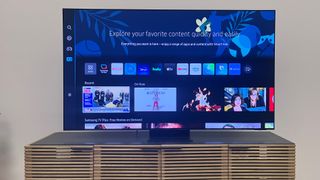
Specifications
Reasons to buy
Reasons to avoid
✅ You want 144Hz gaming: The Samsung S95C offers 144hz refresh rate and can even incorporate this for PC gaming formats.
✅ You want a premium QD-OLED picture: The Samsung S95C is brighter than the S90C and has spectacular contrast and color that will make your games pop.
❌ You want the best value gaming TV: Stacked with features, the S95C does carry a higher price than other well-equipped gaming TVs.
❌You want the best picture out-of-the-box: To get the best picture, you will need to do some tweaking to the Samsung S95C's presets especially its Standard mode
The Samsung S95C is the company's second generation QD-OLED TV and outguns the previous-gen S95B TVs by a long shot, especially when it comes to brightness. The S95C models have close to 40% more brightness than its predecessors, taking HDR movies and games to another level. During our testing, we measured peak brightness to be as much as 1,400 nits on a white HDR window covering 10% of the screen. While the set can't sustain these levels for long before having to start dimming, most video and gaming content changes regularly enough not to noticeably trigger the dimming setting. This is around 70% brighter than the LG C2, which is incredible.
We didn't find many issues with the set, but we did notice some. One was that the S95C's default 'Standard' picture preset can cause colors to look slightly desaturated in places, although this can be improved by toning down the dynamic tone mapping setting. Another gripe of ours was the lack of a Dolby Vision HDR format. As we said in our review: "The S95C’s 4K resolution is backed up by support for the HDR10, HLG and HDR10+ HDR formats. This is fine so far as it goes, but Samsung’s continuing refusal...still frustrates. Especially given how widespread content mastered in Dolby’s premium HDR format is."
Where the Samsung S95C really shines is its gaming features. With support for HGiG HDR system, Auto Low Latency Mode switching, a refresh rate that extends to 144Hz and an incredibly fast response speed of 9.2ms, the set is ideal as a gaming monitor. The S95C also supports ultra-wide aspect ratios of 21:9 and 31:9 that some PC titles have.
Although the S95C is significantly brighter (around 30%) than the Samsung S90C at the top of this list, it comes with a significant price jump, and we think the S90C is easily bright enough for most people. This is the best of the best for OLED picture punchiness, but most people will be happier saving the money and getting the S90C.
Read our full Samsung S95C review
An ideal 120Hz OLED TV for PS5

Specifications
Reasons to buy
Reasons to avoid
✅ You want great sound with your games: The Sony A80L has a powerful and immersive built-in sound that will add that extra layer to your games.
✅ You want a quality image for your PS5: The Sony A80L's excellent contrast and perfect for PS5 HDR tone mapping create a brilliant image for your PS5 games.
❌ You want the full suite of gaming features: Sadly, you can't have Dolby Vision and 4K 120hz running at the same time on the Sony A80L.
❌You want the best value OLED for gaming: The Sony A80L is priced higher than a lot of its rivals including the Samsung S90C and LG C3.
The Sony A80L is a mid-range OLED from Sony that performs extremely well, delivering incredible 4K clarity, a beautifully refined picture, deep blacks and color handling that we called “mesmerizingly precise” in our review. There are also a bunch of top gaming features here, as well as support for Sony's 'Perfect for PS5' features, which include a special HDR mode just for the console, and custom gaming settings depending on the genre.
It replaces the 2022 version – the Sony A80K – in our list and the major addition here is a new XR Clear Image feature. This promises cleaner and crisper 4K upscaling of any sub-4K imagery. But otherwise the XR OLED Contrast Pro, color-related XR Triluminos Pro and XR OLED Motion features are unchanged between the two models. This is no bad thing considering that Sony’s Cognitive XR processor achieved near-universal praise in previous iterations.
Although the picture is worth shouting about, there’s strong and immersive sound quality on offer here too. The A80L’s Acoustic Surface sound system pushes its sound directly forward into your room and places effects with more accuracy for a more impactful experience.
Although we think the Sony A80L is deserving of a place in our best 120Hz 4K TVs guide, it does come with some limitations. The main being that only two of the A80L’s HDMIs support 4K at 120Hz with VRR, and the TV can’t support Dolby Vision at 4K 120Hz at all. This doesn’t mean you shouldn’t consider it. It’s an excellent choice for buyers who want the deep contrast of OLED but don’t want to pay top dollar for the tech. But there are better gaming TVs out there if you don't want the PS5-specific features.
Read our full Sony A80L review
Other 120Hz TVs to consider
Support for 120Hz gaming has become an increasingly popular feature on TVs, so numerous models we've recently reviewed didn’t make the cut for this list but are otherwise worthy of consideration.
The LG G3 OLED is an excellent option for both movies and gaming and one that competes directly with the Samsung S95C OLED which currently ranks as the best premium OLED TV in this guide. However, LG’s flagship OLED doesn’t match the Samsung's full-screen brightness, which is an important consideration for gaming. Otherwise, the LG G3 is stocked with gaming features, including four HDMI 2.1 inputs with 4K 120Hz support.
Anyone wanting a step-up mini-LED alternative to our budget choice, the Hisense U8K, should also look at the Samsung QN90C. This set delivers impressive brightness and has 4K 120Hz input support on all four of its HDMI 2.1 ports along with FreeSync Premium. Like other Samsung TVs, the QN90C has the company’s built-in gaming hub for cloud-based gaming via apps such as Xbox, Nvidia GeForce Now, Utomik, and others.
A model closer to our budget pick’s price range is the Samsung Q80C. A QLED TV with a regular LED backlight instead of the mini-LED one found on the Hisense U8K, the Q80C doesn’t manage the same high brightness levels as the Hisense, but similar to the Samsung QN90C has 4K 120Hz input support on all four of its HDMI 2.1 ports along with FreeSync Premium and Samsung’s Gaming Hub.
How to choose the best 120Hz TV
Choosing the best 120Hz TV for you isn't too different from choosing any other TV – it just means that you've settled on one crucial element already (whether you want a 60Hz screen or a 120Hz screen), which means you'll be buying more from the premium end of things.
But the other questions remain open. For example, do you want an OLED or an LED TV? We've written a an OLED vs LED vs LCD guide that covers the tech types in depth, but in summary, LED has a backlight whereas OLED pixels produce their own light.
OLED might seem like the better, cooler type of tech – and in many ways it is – offering excellent contrast and viewing angles, but you might get better brightness and/or a cheaper price with an LED or mini-LED TV. Response times do tend to be better with OLED TVs, too, which means if you're after the best TV for gaming, we'd usually suggest you pick OLED – unless you play during the day in a bright room, in which case a mini-LED would be preferable.
HDMI 2.1 ports are very important, because this is what's required to receive a 4K 120Hz signal from your console. All 120Hz TVs will include at least two, but some LG and Samsung TVs comes with four HDMI 2.1 ports, and if you're a hardcore gamer who'll own multiple consoles, we strongly recommend choosing one of these.
Admittedly, some players may not notice a drastic difference when they first use a 120Hz TV with a next-gen console, but we think that refresh rates are crucial for certain games. For example, you'll really be able to see a difference in fast-paced shooters or racing games, where quick reflexes and frame pacing counts.
It might seem like an obvious consideration, but bear size in mind when you're looking for a new 120Hz 4K TV. If you're going to be using it as your main screen, you'll need to be sure it fits into the space you have available. If it'll be in a second room specifically for gaming, you might not want to go for the biggest available size but instead choose a small display, such as the LG C3, which is available at 42 inches.
And don't forget sound. A lot of TVs don't have great built-in speakers, but some are better than others. If you'll play mostly with a headset, then that's no problem either way. If you already own one of the best soundbars, or are happy to buy one, then that solves the problem too. But if you don't want any extras, look out for TVs we've mentioned as including great audio.
What TVs are coming in 2024?
So far in 2024, we've seen a lot of new TVs announced, a lot of which carry 120Hz (and 144Hz) support.
The most notable that we've spotted so far is the LG B4, as this new model is getting 4x HDMI 2.1 ports with 4K 120Hz support, which could make it one of the top 120Hz TVs and best gaming TVs of 2024. Also from LG, we're getting the LG C4 and LG G4, both of which will now support up to 144Hz for PC gaming as well.
Samsung is releasing several new models including its two QD-OLEDs, the Samsung S90D and Samsung S95D. Samsung also unveiled its mini-LED TV lineup for 2024, which will include the Samsung QN900D - an 8K, 'floating' gaming TV.
As for other brands TCL announced its new mini-LED TVs for 2024 and Hisense also continued its mini-LED loyalty with its 2024 lineup, and a lot of the TVs in the two brands' range support 120Hz.
For UK based gamers, Panasonic's new Fire TV 2024 OLEDs will support 120Hz and Philips confirmed a lot of its 2024 OLEDs will support up to 144Hz as well.
We haven't been able to get a full, gaming testing with these models yet but once we do, we'll be sure to update this guide with our impressions.
120Hz panel: why does it matter?
Do refresh rates really matter enough to justify buying a new television set? We'd argue that without an advanced television, the upgraded hardware in your new Sony or Microsoft console becomes superfluous. All that power won't translate into better performance unless your TV can support it.
Hertz, or refresh rate, determines the number of frames that your television can display per second. Because both the PS5 and Xbox Series X can generate 120 frames per second (fps) in 4K UHD resolution, you need a television panel that works up to 120 Hertz to make that mode work.
An older 4K TV likely can only support 60Hz/4K. That worked perfectly well with the Xbox One X and PS4 Pro, both of which could hit 60fps in 4K for some games.
With a higher refresh rate in 4K, you'll see a smoother and sharper output on the television with less nauseating motion blurring when you turn the camera quickly in-game. This is particularly handy for fast-paced shooters where you need to turn on a dime and react quickly to threats. But the visual boost from increased frames isn't limited to any one genre of game.
Several of our top picks feature a 144Hz refresh rate. This isn't an essential upgrade over 120Hz in our opinion – read our guide to whether 144Hz TVs are a big deal for why – but the option is there for hardcore PC gamers who might want to try it.
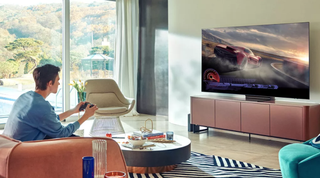
HDMI 2.1: What does it do?
HDMI 2.1 is a more powerful data transfer standard that improves your television's capacity to handle high refresh rates and resolutions simultaneously. That said, this new standard also adds two other important gaming features by default: Variable Refresh Rate (VRR) and Auto Low Latency Mode (ALLM).
VRR is a tool that enables your TV to automatically adjust its Hz based on the output from your gaming console. While the Xbox Series X and PS5 offer a 120Hz 4K maximum, individual games' frame rates will fluctuate and drop based on what's happening on screen. The more frames you drop, the more tearing and stuttering you'll see as the television tries to adjust.
With VRR activated, your television will adjust its refresh rate on the fly so it never deviates from the game's fps output. That way, even if the game performance is struggling, the gameplay will remain smooth and seamless.
As for ALLM, it detects when you're playing a video game and adjusts your TV settings on the fly to reduce input lag as much as possible. It's a simple but essential feature that ensures you don't need to switch manually from Game to Cinema mode over and over.
Here's the problem, though: the HDMI Forum recently changed the rules, meaning that HDMI ports can now be labelled as HDMI 2.1 even if they don't support all of these features. So you can't just look for 'HDMI 2.1' in the specs and know you're covered, you'll need to check for these features specifically.
For more on the differences between refresh rate, input lag and refresh time, read our guide: Input lag and monitor speed explained.
How we test the best 120Hz TVs
We review TVs with a range of different content. Of course, next-gen gaming takes priority in this guide, but we imagine you'll also want to know what movies and TV shows are like to watch as well.
In order to test the input lag, we use a Leo Bodnar 4K HDMI Video Signal Lag Tester, which sends a signal to the TV and measures how quickly that signal is visible using its own sensor. We use colorimeter to test the brightness levels and color accuracy of the TVs, in conjunction with a bit-perfect test pattern generator to create the images that are measured. We connect a latest-gen game console to ensure that features such as 4K 120Hz support, variable refresh rate, or Dolby Vision gaming work as expected.
As well as judging all of the key specs you need in a gaming TV, such as refresh rates and HDMI connection options, we're also looking for good picture quality, vibrant colors and viewing angles to suit all kinds of rooms.
Sound is less of a priority with most gaming TVs as you'll get the best experience from gaming headphones or a soundbar, but it's always good to know you'll get a decent built-in experience. Which is why we've also detailed what it was like to listen to these TVs without additional devices, too.
Because we've reviewed many TVs over the years – and many of the best gaming TVs – all of our testing isn't done in isolation, but takes into account what else is available, so we only recommend the options most worth your time.
The latest updates to this best 120Hz TVs guide
11 April 2024
Updated with testing results graphs, to make it easy to compare our TVs recommendations.
5 February 2024
Updated FAQ's section with 'TVs coming in 2024' to include info to what 120/144Hz TVs we're most looking forward to this year.
Read more updates
20 December 2023
Added in the 'Buy it if' boxes to give the pros and cons for each entry and how they relate to gaming.
10 November 2023
Replaced the LG B2, LG C2, Sony X90K with their 2023 equivalents, the LG B3, LG C3 and Sony X90L. Removed Sony A95K and 'best image quality' category and combined it with Samsung S95C, which became 'Best premium 144Hz OLED'. Hisense U8K became 'Best value TV' for both US and UK.
8 August 2023
Removed the Samsung QN85B. Replaced the LG C2 as 'Best for most people' with the Samsung S90C based on our reviews. Re-titled LG C2 as the best option for different size needs.
26 June 2023
Added this 'latest updates' section, to help readers see what recent changes have been made. Checked the products in the list against our latest reviews.
23 May 2023
Added more buying advice to the end of this guide, including more technical details. Checked all products against our latest reviews.
20 April 2023
Changed the structure of this guide to make it easier to navigate, and to find particular models that suit different needs. Added Samsung S95C to the list, and removed some models.
12 March 2023
Added TCL 6-Series Roku TV (2022) to the list, removed Hisense U7G.
Get daily insight, inspiration and deals in your inbox
Get the hottest deals available in your inbox plus news, reviews, opinion, analysis and more from the TechRadar team.

Matt is TechRadar's Managing Editor for Entertainment, meaning he's in charge of persuading our team of writers and reviewers to watch the latest TV shows and movies on gorgeous TVs and listen to fantastic speakers and headphones. It's a tough task, as you can imagine. Matt has over a decade of experience in tech publishing, and previously ran the TV & audio coverage for our colleagues at T3.com, and before that he edited T3 magazine. During his career, he's also contributed to places as varied as Creative Bloq, PC Gamer, PetsRadar, MacLife, and Edge. TV and movie nerdism is his speciality, and he goes to the cinema three times a week. He's always happy to explain the virtues of Dolby Vision over a drink, but he might need to use props, like he's explaining the offside rule.
- Amelia SchwankeSenior Editor UK, Home Entertainment
- James DavidsonTV Hardware Staff Writer, Home Entertainment
